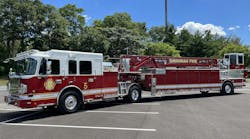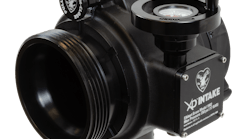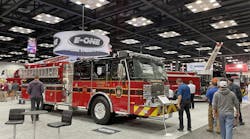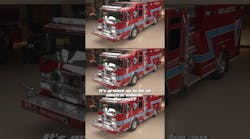Tom Shand and Michael Wilbur explain why, with municipal budgets getting tighter and funds for capital projects becoming scarce, it is more important than ever to develop an apparatus-replacement program for your department.
With the beginning of a new year, it is appropriate to reflect back on our travels from 2008 with the many fire departments that we visited and offer a few comments on some of the apparatus fleets that were impressive for many reasons.
With municipal budgets getting tighter and funds for capital projects becoming scarce, it is more important than ever to develop an apparatus-replacement program for your department. Even if there are no funding issues on the horizon for your organization, it is still prudent to have a well-developed and well-thought-out replacement program that will meet the needs of the community as well as provide safe and reliable apparatus for your personnel. If you feel you need help developing a plan, seek the services of an apparatus architect. The help provided could prove to be invaluable.
Whether your present fleet is comprised of units that were purchased new or is made up of new and used equipment, the balance between providing needed services to your community balanced against operating costs is more important than ever. Following are a few examples of departments operating in different areas of the country and how they addressed their apparatus requirements while balancing the total costs of ownership over the life cycle of the vehicles.
Orrville, OH, is in Wayne County, in the southeastern portion of the state, and is home to many commercial and industrial properties, including the J.M. Smucker Co. The fire department protects approximately 11,500 people within a 25-square-mile area and responds to over 500 incidents each year. The department is under the command of Chief Robert Ballentine, who oversees 40 personnel responding from two stations.
The department operates three engines, one ladder tower, a heavy rescue, a tanker and an ambulance with a mix of different apparatus body builders. The department's ladder truck is a 1999 American LaFrance equipped with a 100-foot LTI rear-mount ladder tower. Portions of the aerial device were transferred from an older unit, rebuilt and remounted on the new chassis together with a new fire pump, water tank and body components. After the department took delivery of this rebuilt apparatus, several units within the fleet began to show their age, including an older walk-in rescue truck and an overloaded mini-pumper.
The department sought to design a single unit to replace both older rigs, which resulted in a combination rescue engine equipped with a 1,250-gpm pump, 500-gallon water tank, light tower, hydraulic generator and full complement of rescue equipment. Rescue 63 carries all of the equipment that was previously carried on the other department vehicles and ultimately replaced three rigs, reducing maintenance and insurance costs for the department.
The Mount Horeb Fire Department protects several villages and the greater portion of six towns in Dane County, WI, with a population of over 13,000 people within 125 square miles. The department is led by Chief Charles Himsel, who commands 65 volunteer personnel operating from one centrally located station. The department's apparatus fleet consists of three engines, one ladder, one heavy rescue, a brush unit and an ambulance that are all painted in the unique Mount Horeb "Safety Black" graphics.
Each apparatus in the Mount Horeb fleet has unique design characteristics such as a fully enclosed top-mount pump panel that incorporates crew seating on the Peterbilt chassis, a fully enclosed rear hosebed and low-mounted crosslays built into the pump enclosure. While the department's front-line structural apparatus were in good shape, there was a need to provide a unit with off-road capabilities for rural and brushfire incidents. With this in mind, Himsel contacted the local Defense Reutilization and Marketing Office to inquire about obtaining a former U.S. military apparatus for Mount Horeb.
As a result, the department acquired a 1990 Amertek MACI 1,000-gpm pumper and had the unit rebuilt by CustomFIRE. Engine 3 also is equipped with a 660-gallon water tank and a 40-gallon foam cell. The apparatus was outfitted with additional compartments, warning lights and a reconfigured hosebed that now accommodates four pre-connected lines, including a blitz fire gun and split supply-line beds, each carrying 700 feet of four-inch hose. This apparatus provides an additional resource for the department at a fraction of the cost of a new piece of equipment.
The Arundel Volunteer Fire Company in Gambrills, MD, operates as Station 7 in the Anne Arundel County Fire Department and covers a large first-due area between the Route 50 and Route 301 corridor. The station is staffed with a combination of career personnel and volunteers under the leadership of Chief David Ayers. Apparatus in the station consists of two engines, a heavy rescue and an ambulance. The station responds to over 3,000 calls for service per year, including many traffic accidents in the first-due area and in adjacent Prince George's County.
The station has operated a heavy rescue for years, including several older units that were purchased used to initially gain the experience in rescue equipment and operations. The present Squad 7 is the fourth heavy rescue acquired by the department and is a 2008 Seagrave Marauder II walk-in unit. The previous squad was built on a commercial chassis; in an effort to improve crew safety as well as increase the equipment-carrying capability of the unit, a two-door custom chassis was chosen that incorporates a transverse compartment in the cab area for a Stokes basket, long boards and other gear.
Squad 7 carries an assortment of truck company and rescue equipment, including ground ladders, a portable generator, hydraulic rescue tools, shoring blocks and lighting gear. The walk-in portion of the body has storage areas for EMS equipment, meters, hand tools and seating for six personnel. Many hours were spent designing and laying out the body compartments to accommodate all of the needed equipment and allocate space for future equipment acquisitions.
All three of these fire departments carefully planned out their apparatus fleets to meet the needs of their communities while operating within budget constraints from a practical standpoint. If you are in the area of any of these locations in Orrville, Mount Horeb or Arundel, the stations and apparatus are worth the investment in time to check out what these fire departments have accomplished with their resources.
The next installment of "The Apparatus Architect" will discuss program-type pumpers and the potential advantages of these types of units.
TOM SHAND, a Firehouse® contributing editor, is a 33-year veteran of the fire service and works with Michael Wilbur at Emergency Vehicle Response, consulting on a variety of fire apparatus and fire department master-planning issues. He is employed by Seagrave Fire Apparatus LLC as a regional sales manager. MICHAEL WILBUR, a Firehouse® contributing editor, is a lieutenant in the New York City Fire Department, assigned to Ladder Company 27 in the Bronx, and has served on the FDNY Apparatus Purchasing Committee. He consults on a variety of apparatus-related issues around the country. For further information, access his website at www.emergencyvehicleresponse.com.





